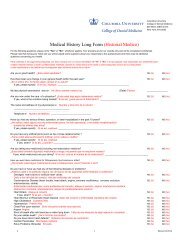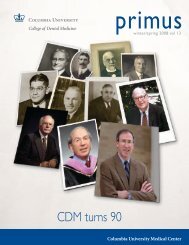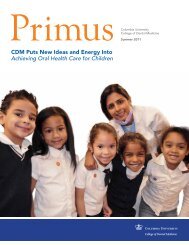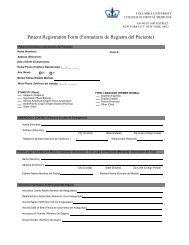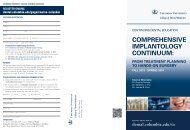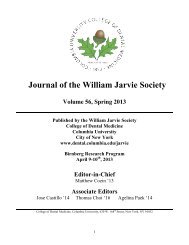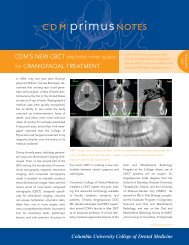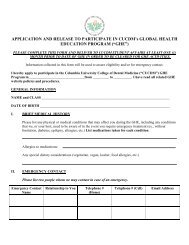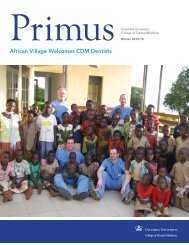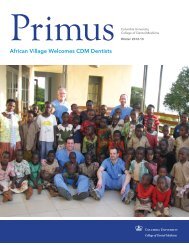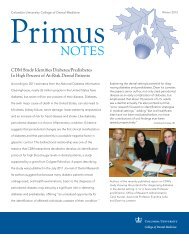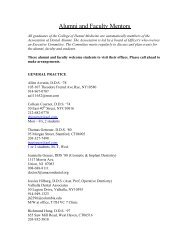Dr. Uyanik listens to a PainCenter patient describe hersymptoms.work harder to bring the teeth together, which mayinduce muscle spasms in the head, neck and jaw.Clenching or grinding teeth (bruxism), trauma tothe head and neck, or working under poorergonomic conditions, can all provoke TMJ pain.Pain can develop in ears, eyes, sinuses, cheeks, or theside <strong>of</strong> the head, and clicking – or even locking –may strike while moving the jaw. Psychological factorslike stress, depression, and panic attacks canalso play an important role in the etiology and maintenance<strong>of</strong> or<strong>of</strong>acial pain symptoms. When jawpain deprives patients <strong>of</strong> their ability to chew, swallow,and sleep, they experience a debilitating deficitin their quality <strong>of</strong> life and may become withdrawn ordepressed. It is even possible for chronic or<strong>of</strong>acialpain to outlive being defined as a symptom and takeon the role <strong>of</strong> a disorder. Chronic or<strong>of</strong>acial pain suffererscould also become more susceptible and irritableto new stimuli.While the clinical management <strong>of</strong> temporomandibulardisorders has progressed rapidly fromthe 1920s to today, its future should be evenbrighter as scientists focus their efforts on identifyingthe biological, psychological, and genetic riskdeterminants that lead to muscle and joint pain.The National Institute <strong>of</strong> <strong>Dental</strong> and Crani<strong>of</strong>acialResearch (NIDCR), directed by Lawrence Tabak ’77,“... recognizes a unique opportunity ... with theemergence <strong>of</strong> genomic, proteomic, and other powerfulinformation-generating technologies, to definein greater detail the genetic and molecular basis <strong>of</strong>pain [which should allow] future clinicians to moreselectively and efficiently control the pain process.”
New Insights Into TMD’sPathology and Treatment“...A WILDLY MOBILE ... HULA-DANCINGHINGE THAT GOES SIDE TO SIDE,BACKWARD, FORWARD, UP, DOWN.A picturesque description <strong>of</strong> thesometimes temperamental temporomandibularjoint (TMJ) appeared in theApril <strong>2006</strong> Health Section <strong>of</strong> the New York Times. Itwas written following a discussion <strong>of</strong> TMJ problemsbetween the reporter and Dr. Heera Chang,Assistant Pr<strong>of</strong>essor <strong>of</strong> Clinical Dentistry in theDivision <strong>of</strong> Oral and Maxill<strong>of</strong>acial Surgery at<strong>Columbia</strong>’s <strong>College</strong> <strong>of</strong> <strong>Dental</strong> <strong>Medicine</strong>. Bothwriter and doctor had suffered their own bouts <strong>of</strong>temporomandibular joint disorder (TMD) and, typically,both are women. As Dr. Chang explainedduring the interview, “Women come in right away,”when they feel pain or experience movementproblems in the jaw joint, but, “men come in andsay, ’I’ve had this problem for nine years.’“IT CAN EXERT650 TO 1000POUNDS OF FORCEPER SQUARE INCH...”Dr. Chang’s personal experience with TMDoccurred in college and was responsible for herdecision to pursue a career in science and dentalmedicine. She attended the <strong>University</strong> <strong>of</strong>Wisconsin, graduating with a Bachelor <strong>of</strong> Sciencedegree in 1992. She became Dr. Chang in 1998,when she earned her DDS at <strong>Columbia</strong>’s <strong>College</strong><strong>of</strong> <strong>Dental</strong> <strong>Medicine</strong>, receiving numerous studentawards for research. A decision to go on for a seconddoctoral degree, in medicine, took her to the<strong>University</strong> <strong>of</strong> Connecticut, where she honed hersurgical expertise. Today, in addition to trainingOMFS postgraduates at CDM, she is a clinical specialistin reconstruction and implantation, and thetreatment <strong>of</strong> maxill<strong>of</strong>acial trauma and temporomandibulardisorders. She has remained dedicatedto research as a means <strong>of</strong> strengthening her understanding<strong>of</strong> the field in which she practices.As interesting as the psychological rationale forgender differences in reporting TMD may be, Dr.Chang has focused her recent research efforts onexamining the biochemical pathology <strong>of</strong> this syndrome.In the June 2005 issue <strong>of</strong> the Journal <strong>of</strong> Oraland Maxill<strong>of</strong>acial Surgery, Dr. Chang and her coauthor,Dr. Howard Israel, published results fromtheir study “to find a correlation between biochemicalmarkers and joint pathology” for TMD.Before its publication, Dr. Chang presented materialfrom the article, for which she won the bestresearch abstract <strong>of</strong> the session, at the 2003 annualHeera Chang, DDS, MD,examines a TMD patient.primus<strong>2006</strong> 13



